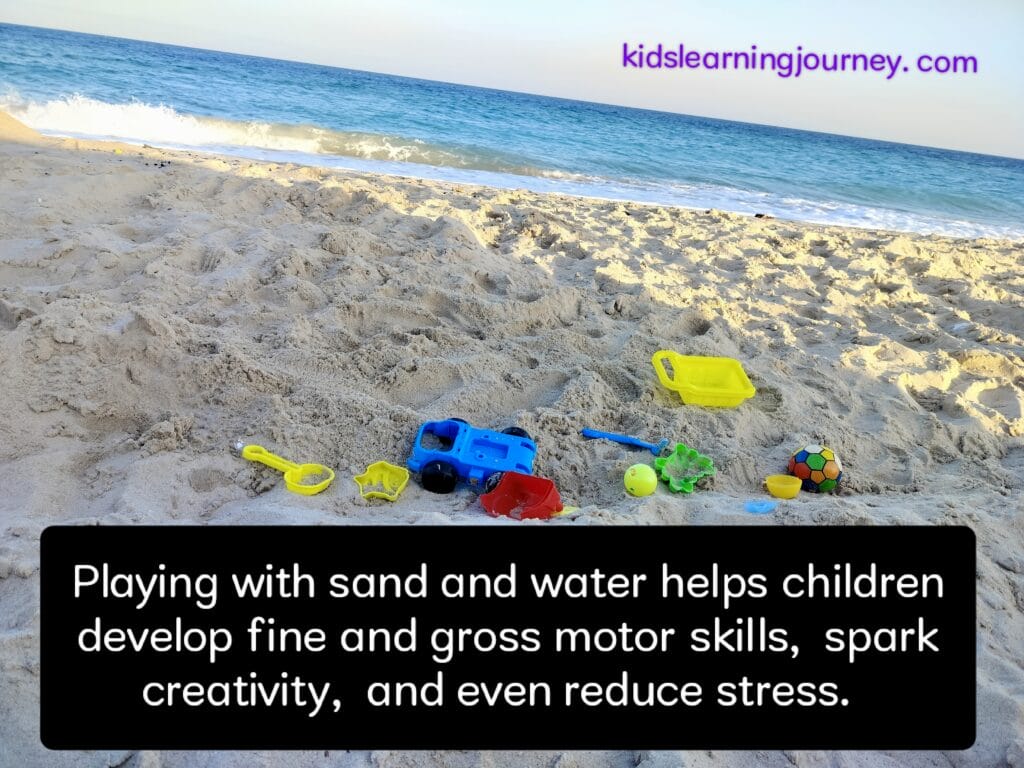According to Research Gate Sand and Water Play Can Unlock Early Learning Through Fun and Exploration.

Kids naturally love playing with sand and water—they dig, pour, splash, and build, making for endless fun. But beyond the enjoyment, these simple activities play a crucial role in their development. Playing with sand and water helps children develop fine and gross motor skills, spark creativity, and even reduce stress. It’s also a great way to take a break from screens.
In this article, we’ll explore how sand and water play can enhance your child’s learning journey in surprising ways.
1. Sand Play: A Natural Stress Reliever
Playing with sand has a calming effect on the mind due to its natural scent and soothing texture, much like sensory therapy. The repetitive motions of scooping, pouring, and sifting help regulate emotions and reduce anxiety.
Research shows that sensory play can lower cortisol levels, the hormone linked to stress. This hands-on activity allows children to relax and express themselves freely, making it a perfect way to unwind after school, stressful studies, and exposure to flashing screens.
2. Tiny Hands, Big Skills: Building Fine Motor Strength
When kids dig, mold, or scoop sand and water, they’re strengthening their fine motor skills—those small muscle movements essential for writing, buttoning clothes, and using utensils.
Pouring water into containers, squeezing wet sand to make shapes, and tracing letters in the sand all help strengthen hand-eye coordination and dexterity. These small yet crucial skills lay the foundation for future learning.
3. Strong Bodies, Strong Minds: Gross Motor Development
Sand and water play isn’t just about tiny movements—it also encourages full-body engagement. Lifting buckets of water, pushing sand with shovels, or jumping in puddles strengthens core muscles, balance, and coordination.
From building sandcastles to drawing patterns in wet sand, children use their imagination to bring their ideas to life. Open-ended play encourages problem-solving, innovation, and storytelling skills.
Whether they’re designing a fortress, digging a pretend river, or writing messages in the sand, they’re developing creative thinking that benefits them in all areas of learning.
4. A Playground for the Imagination: Boosting Creativity
From building sandcastles to drawing patterns in wet sand, children use their imagination to bring their ideas to life. Open-ended play encourages problem-solving, innovation, and storytelling skills.
Whether they’re designing a fortress, digging a pretend river, or writing messages in the sand, they’re developing creative thinking that benefits them in all areas of learning.
5. Nature’s Immune Booster: Strengthening the Body’s Defenses
Exposure to outdoor elements like sand and water helps build a child’s immune system. Research suggests that playing in natural environments introduces beneficial microbes that strengthen immunity, reducing allergies and improving gut health. Unlike sterile indoor play, engaging with nature allows kids to develop a stronger resistance to germs, keeping them healthier in the long run.
Sand and water play isn’t just messy fun—it’s a vital part of childhood development. From reducing stress to enhancing creativity and building essential motor skills, these simple activities provide countless benefits for growing minds and bodies. So, the next time your child asks to dig in the sand or splash in the water, remember—they’re not just playing, they’re learning, exploring, and thriving.
.

